New Coffee Table Book and Limited Blu-ray set Offer an Immersive Portrait of When the Striking Dutch Actress Burned Brightest
BOOK STREET DATE: JUNE 8, 2022/CULT EPICS
LIMITED EDITION BLU-RAY STREET DATE: JANUARY 11, 2022/CULT EPICS
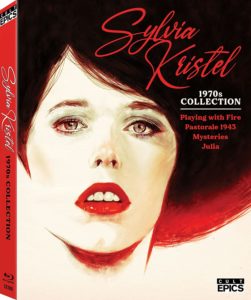
The shimmering ghost of Dutch actress Sylvia Kristel forever hovers over the international sexploitation sub-genre. There’s a distinct sadness in this, as Kristel was both gone too soon, flamed out by illness, but also artistically pigeonholed in her prime. Known globally for her embodiment of the title role of Just Jaeckin’s phenomenally successful Emmanuelle (1973), that sexually liberated character became something of a millstone around the neck of the insightful, feminist actress.
In the ultra-permissive 1970s, finding overt sexual content at the cinema became exponentially common. A racy new lane had opened broadly for filmmakers, filmgoers, and film stars, should they choose to go that route. In the “me decade”, there was no shortage of partakers. Cheap, drecky skin flicks were all over the place, but for an ambitious few, the cultural shift marked an opportunity to artistically explore human sexuality on screen as never before.
That was the oft-expressed dream, anyhow. More often than not, such projects would miss the mark, resulting in something many would dismiss with a shrug as vapid softcore pornography. Sometimes, skeezy producers looking to make a quick buck would talk a grandiose talk only to leave an exclusively lurid final product. It quickly became apparent that one needed to be particularly daring to brave these tides, whatever the motivation.
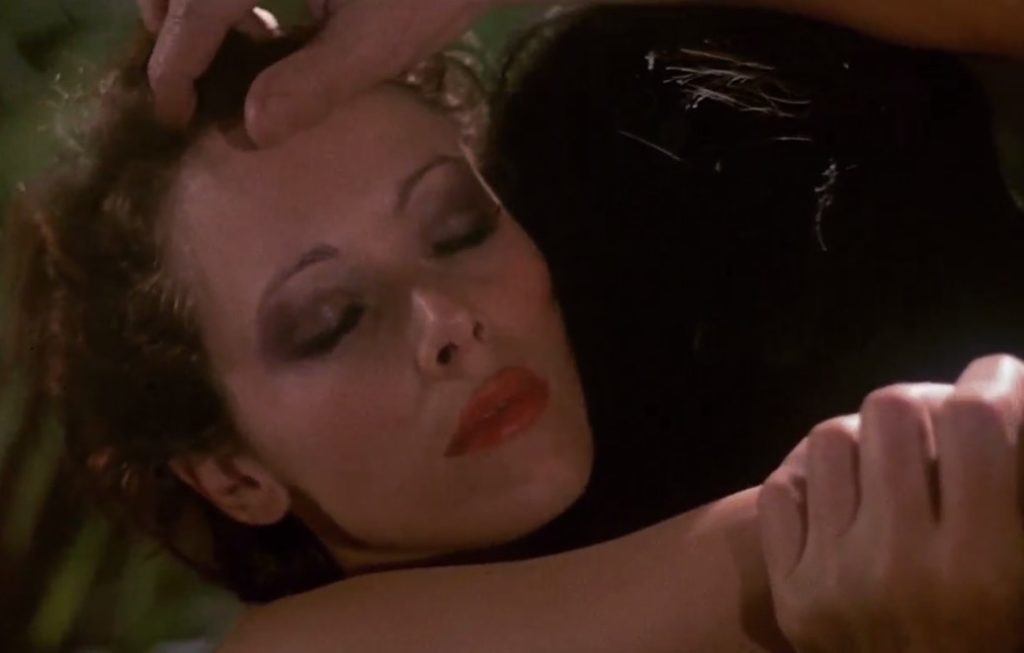
It’s something of a miracle that Dutch screen star Sylvia Kristel managed to transcend much of this, even as she spent her career immersed in it. Though Kristel found herself in all the manner of projects detailed above and then some, she rose above the worst of them and in most cases, elevating every film on her resume. This amid her own growing frustrations with the shape of her own stardom, which sadly gave way to various substance abuse problems. Thankfully, she found her way out of sexploitation… for a time. Even in death, she would forever be linked to Emmanuelle. The promoters of even her most lofty works saw fit to evoke that massively recognized title alongside of her name on posters and whatnot.
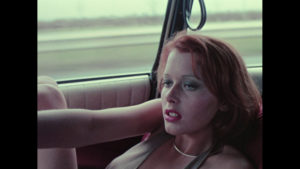
Having gotten her start as a bit player in Pim de la Parra’s and Wim Verstappen’s locally based upstart studio, $corpio Films (1973’s quite frank Frank & Eva, to be exact), she quickly went onto bold starring roles, prominent supporting roles, and show-stealing walk-ons. She even gave Hollywood a shot, prominently appearing in 1980’s Maxwell Smart revival, The Nude Bomb. (Perhaps the film with the raciest title on her resume with no nudity to speak of).
Although Kristel kept busy in subsequent years, the 1970s proved to be her decade de jour. The venerable Cult Epics is celebrating Kristel’s 1970s dominance with not only an outstanding limited edition (only 2500 copies) Blu-ray box set containing four of her more obscure titles, but also a beautiful, exceptionally researched coffee table book by film and music historian Jeremy Richey that closely chronicles her career up until 1981’s Lady Chatterley’s Lover (directed by Just Jaeckin). Individually, either offering would demand legitimate attention. Together, they resolutely resound Cult Epic’s dedication in proclaiming Kristel’s heyday.
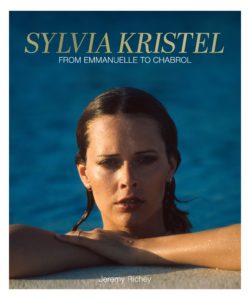
The book is an attractive and classy 334-page affair with a right heft and a true sheen about it, no matter whether it’s open or closed. Full of high-quality film images, promotional stills, poster art, and print advertisements for the various films, every page has something to offer no matter how big of a Kristel fan one is going in. Each chapter is an in-depth consideration of each of her films of this era, no matter her level of participation.
This includes looks at her career emergence phase, such as Jean-Pierre Mocky’s No Pockets in a Shroud (France, 1974) to leading lady parts in Roger Vadim’s Une Femme Fidèle (France, 1976) and beyond, to Walerian Borowczyk’s La Marge (France 1976), and Claude Chabrol’s Alice (France, 1977). Even her less prolific singing career gets its due, as her single “Hey, A Letter Came Today” is included in the context of Frans Weisz’s Naked Over the Fence (Netherlands, 1973), one of her early supporting roles. In order to most effectively spotlight both the Blu-ray box set and Jeremy Richey’s coffee table book, this collective review will focus on the disc collection’s four films (Julia, Playing with Fire, Pastorale 1943, and Mysteries) as they are detailed by the author and myself.
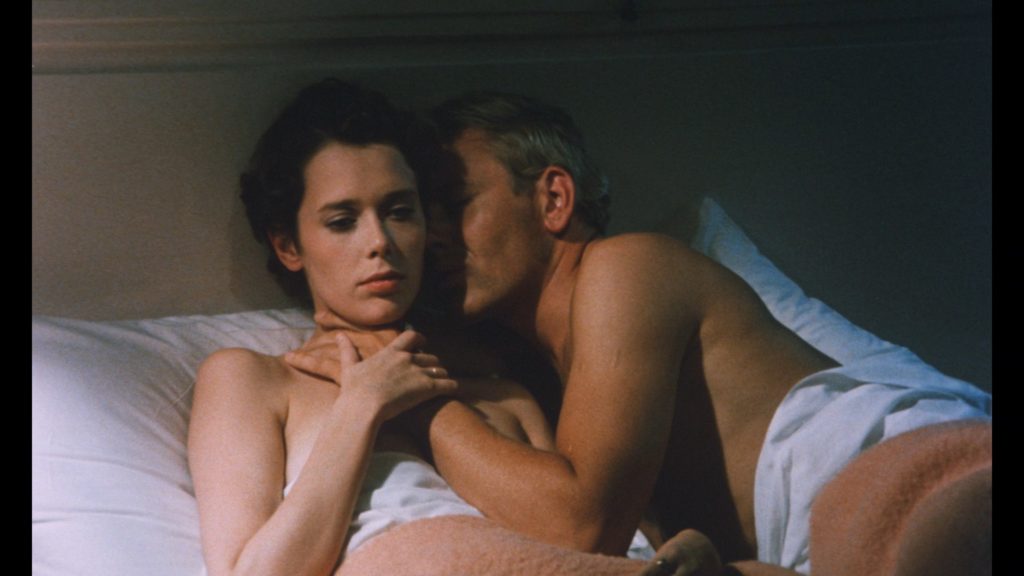
Julia (1974)
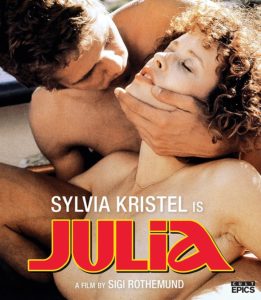
Richey makes no bones of the fact that 1974’s Julia (Es war nicht die nachigall) made a point of riding the pronounced coattails of Emmanuelle. This despite the reality that this somewhat jumbled entry in the “Bavarian Sex Cycle” of the time was actually filmed before the latter phenomenon. It’s tempting to claim that that accounts for Kristel’s limited screen time, as the actress had yet to explode in popularity at the time of Julia’s production. A more certain claim would be the obviousness in naming the movie after Kristel’s character- her first name only, at that. Her character Julia, however brief her cumulative presence, is a vital and unforgettable part of director Sigi Rothemund’s eighty-eight minute sexually charged coming-of-age vacation film.
Richey’s contextual inclusion of a quotation from Shakespeare’s The Tragedy of Romeo and Juliet may strike some as a connective overreach in regard to something like Julia, but the famed play’s central melancholy-escalation is nevertheless apropos. As long as one doesn’t expect Kristel front and center, nor a film that resembles Emmanuelle in any way beyond the general opulent lives of its characters, Julia is a fully satisfactory experience. One of the shared notions that films such as these promote (intentionally or not), that sexual pleasure is really for the super-rich, was not at all coined by them so much as they simply rendered it overtly. It can easily be argued that depictions of such wealthy trappings of the international leisure set is as big of a draw towards these films as the promise of raw sensuality. In any case, it can’t be denied that the breakout commonality of Emmanuelle and Julia is indeed Sylvia Kristel, without whom we would be far less likely to be considering the latter today.
It’s plenty valid to single Kristel’s presence in Julia as something special within it; perhaps even its true lifeblood. Richey seems to agree, writing in his chapter about the film: “in spite of the promotional departments sometimes misleading campaign promising a starring role, Sylvia doesn’t appear until just past twenty minutes in Julia when she floats (on a raft) into the life of our young protagonist. Frequently nude and sporting the same short curly hair that she wore in Emmanuelle, Sylvia remarkably never appears objectified. Instead, in her relatively small number of scenes, Sylvia comes across as gloriously free, seemingly without the burden of institutionalized sexism… Sylvia overcomes the materials misogynistic tendencies and projects youthful independence that is still startling all these decades later.”
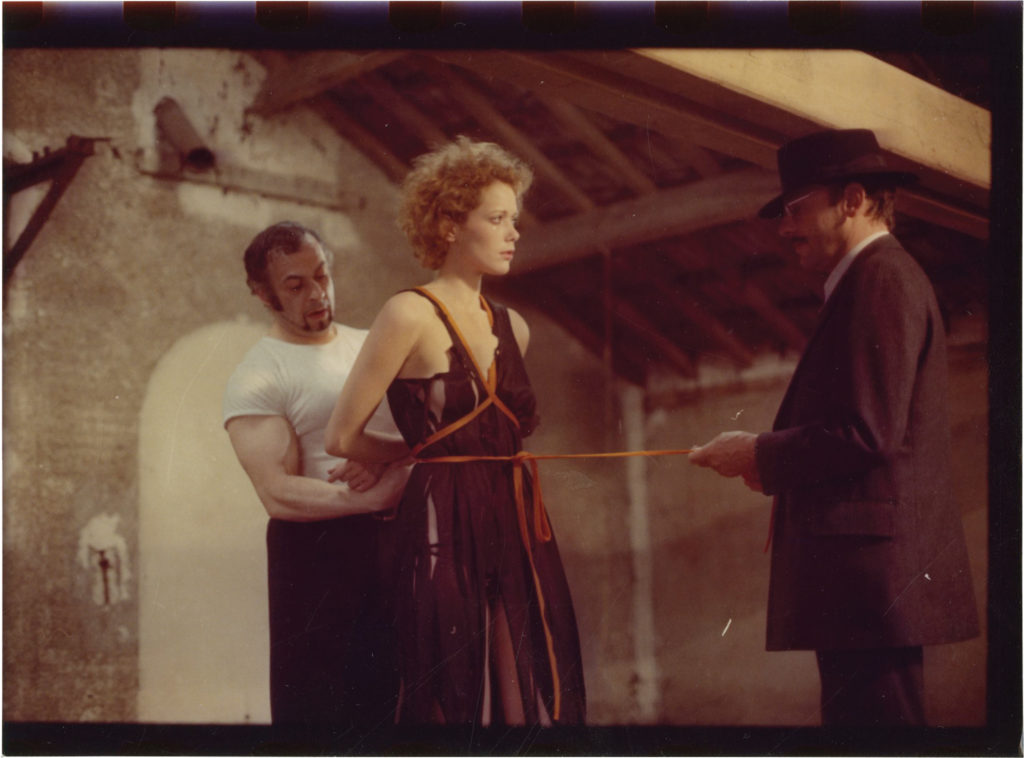
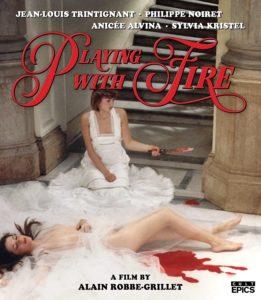
Not all of that could be said about bravura director Alain Robbe-Grillet’s 1975 boat-rocker, Playing with Fire (Le jeu avec le feu). Soooo many other things, however, can and should be said about it. A strange and provocative tale of abduction, Richey explains how the filmmaker drew inspiration from the kidnapping and subsequent brainwashing of Patty Hearst by the Symbionesse Liberation Army. He goes on: “Playfully anarchic and deliciously surreal, Playing with Fire finds Robbe-Grillet at his most gleefully combative. It is a gloriously chaotic film that is probably the most purely entertaining work Robbe-Grillet ever made, and one of the most subversive.” One needn’t be a student of the challenging work of this particularly controversial filmmaker (who came from literature, also cementing his name in film history as writer of Alain Resnais’ landmark 1960 film, Last Year at Marienbad) for those words to resonate as valid. It is easy to pinpoint Playing with Fire as the most brazen, daring, ridiculous, and twisted movie in the Cult Epics Sylvia Kristel Blu-ray box set.
Once again, our featured actress is relegated to a supporting role, albeit a far different type than we saw her play in Julia. By this time a full-blown star, Kristel’s relatively tiny role (as a more mature victimized beauty in the film’s central locale, a lush, sadistic brothel) no doubt came as a bit of a surprise to filmgoers back in the day. The reaction continues today on some level, as many contemporary fans are coming to Playing with Fire via a Blu-ray collection devoted to Sylvia Kristel. Richey points out, however, that the film is in fact important in her then-flourishing career, if only because it elevated her into a high-profile Alain Robbe-Grillet film that starred recently departed screen legend Jean-Louis Trintignant.
Trintignant plays a mystery man of unknown motives amid a proto-Lynchian immersion into kinky perversion, possible physical duality, and wildly manipulated chronology. The true star and focus of the story (such as it is) is young Anicée Alvina as Carolina, the daughter of an extremely rich banker, Georges de Saxe (Philippe Noiret), who has her captured and held in the aforementioned high-end secret brothel. Apparently, this demented move is meant to protect Carolina from the real danger that stalks her… or is it? The girl that de Saxe has kidnapped isn’t his daughter at all… or is she? In a tale brimming with confrontational imagery and out-there filmmaking, narrative cohesion was never high on Robbe-Grillet’s priority list for Playing with Fire. Again though, this is to be expected-perhaps the only thing to be expected- in one of this director’s films. With its inclusion in the Cult Epics Kristel set, the film gets its long-overdue domestic Blu-ray debut- and a handsome one, at that.
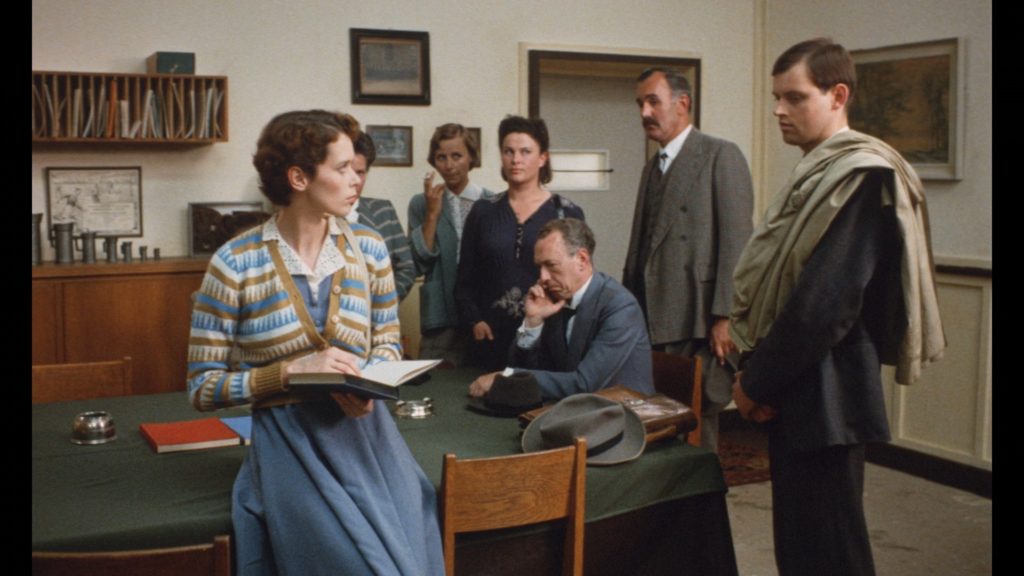
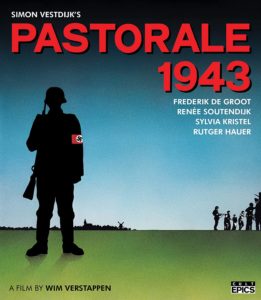
By the time of Wim Verstappen’s 1978 World War II-era drama Pastorale 1943 (based on Simon Vestdijk’s 1948 novel of the same title), Kristel was at peak stardom. Yet, she wasn’t one to turn her back on a filmmaker who first took a chance on her. According to film historian’s Peter W. Verstraten commentary track, since Verstappen (trying to gravitate to a more “respectable” echelon) could never afford Kristel for this project, she opted to appear in Pastorale 1943 for free. Consequently, her role in it can be filed under “Strikingly Brief”.
Pastorale, telling the story of the Dutch resistance to the Nazi invasion of their country in 1940, cannot be said to be the most dynamic or even most engaging film in the Cult Epics Kristel set, but it is representative of the choices and aspirations of the actress, as well as a continuation of the shifting career of Verstappen, post-$corpio. It features measured, precise performances by Rutger Hauer, Frederik de Groot, Geert de Jong, and the big-screen debut of the always-welcome Renee Soutendijk, who’d go on to be a favorite of director Paul Verhoeven in films such as Spetters.
Richey is nothing if not opinionated about the long, often sordid history of “war films”. “The results are often disastrous and overtly offensive, particularly from Hollywood, where war pictures are an excuse to do big-budget special-effects-driven works. Even more appalling is the bottomless pit of war films made as propaganda meant to prop up whatever “right“ side the studio might have seen fit. There have been few genres more artistically bankrupt, and at times completely immoral, than the war film”.
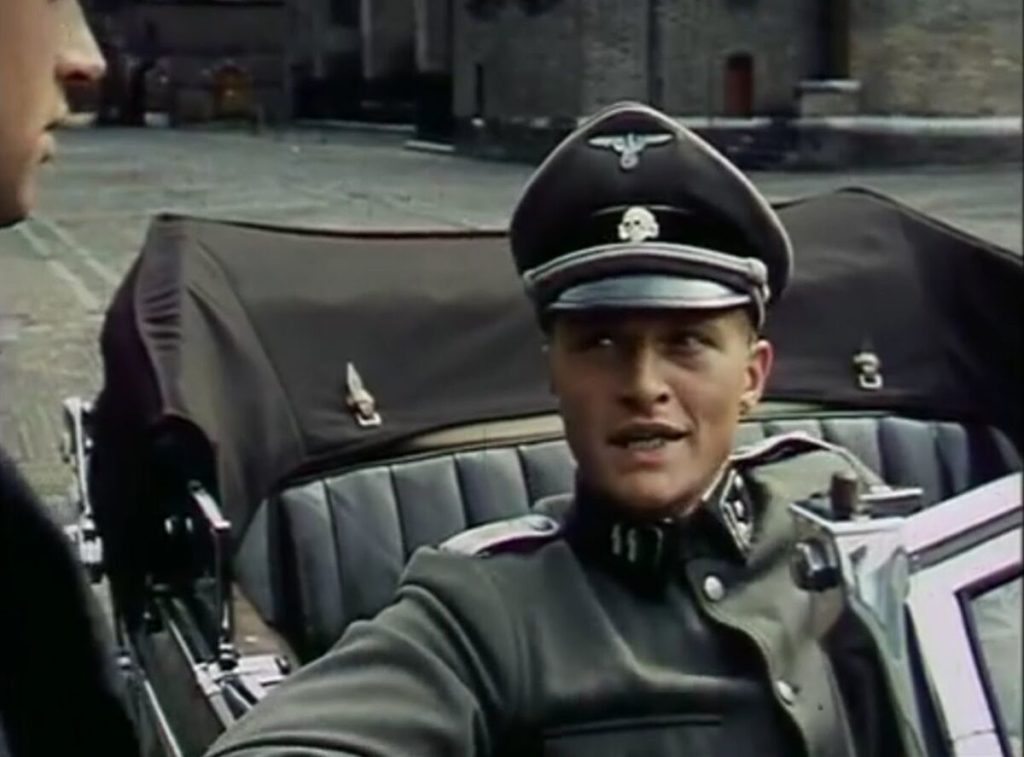
This statement is followed by a brief history of the genre, punctuated by its commercial extremes in its increasingly rudderless 1960 output. It all leads to a thoughtful and valuable take on the muted, battle-free Pastorale 1943: “Verstappen‘s Pastorale 1943 is a significant entry in the crowded war film genre and provide startling insight to the Dutch resistance to the German occupation of World War II. Far removed from the bloodthirsty big-budget offerings that Hollywood and other prominent film markets routinely put out, Pastorale 1943 is a profoundly human, subtle and somber work that reflects the confusion and danger that war thrives on”.
He goes: “One of the critical elements of Pastorale 1943 is the sense of confusion at the heart of the resistance. There’s an element of clumsiness in Pastorale 1943 unique among war films, and it elevates the movie at every turn. Never before has the confusion in the eye of the war’s storms been captured so eloquently.” Indeed, the film is an accomplishment, if perhaps not quite as triumphant as all that. It must be said, however, that Verstappen photographs the German swastika with appropriate heavy ominousness and directs this film with restrained surehandedness.
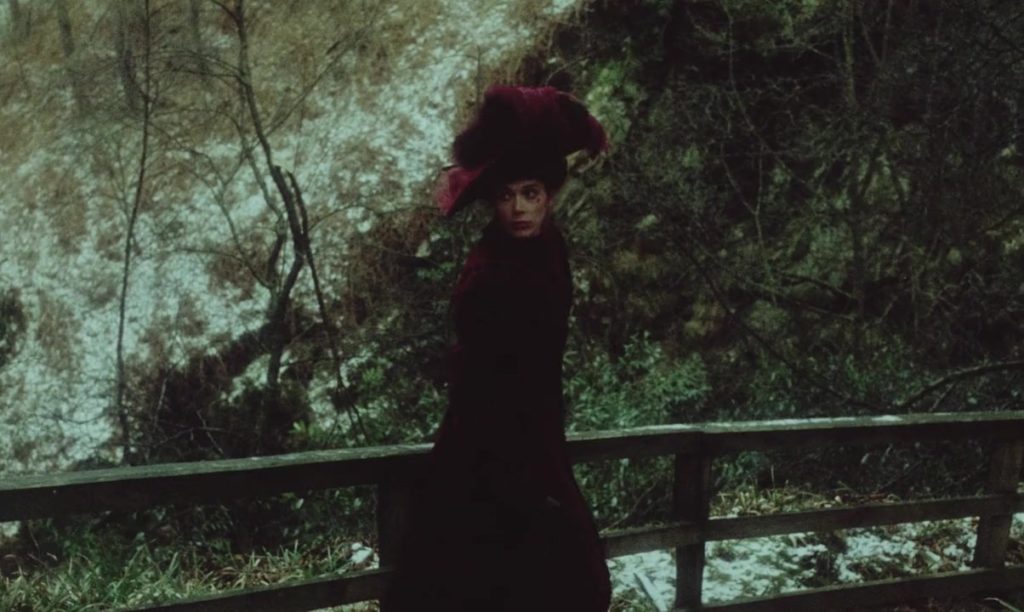
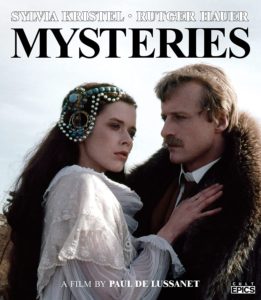
In 1978’s beautifully wrought drama Mysteries, Kristel plays a character that fully embodies her enigmatic persona, perhaps even the whole of her early career. She’s not in it much, although her character is of primary importance. Aloof and wielding a royal fatale quality (circa 1891, when the film takes place), she has been, as the song is sung, the ruin of many a poor boy. Will our protagonist, the differently mysterious Johan Nagal, played by Rutger Hauer, be next?
Like Pastorale 1943, Mysteries is adapted from a highly regarded novel, this one by prolific Nobel prize-winning Norwegian author Knut Hamsun. Originally published in 1892, long before Hamsun would go on to side with and even meet Hitler and Goebbels, his book Mysteries made its mark. The once-celebrated late author’s tainted political history is just one reason why Mysteries was a challenging adaptation to film. It’s a story that is both big yet internal; staunchly of its time yet brazenly ahead of it. Director Paul de Lussanet manages the task well enough, his result being at times cumbersome but never lifeless.
Mysteries is an admittedly difficult film to warm up to narratively, insofar as Hauer’s seemingly wealthy character remains, well, a mystery throughout. Amid that, Richey is correct in stating that the actor was “at the peak of his powers, and it is transfixing watching him and Sylvia together”. (This holds true even as the story never allows for the degree of sexual heat that many fans, keen to both actors’ erotic reputations on screen, were anticipating). To everyone’s credit, including fellow notable actors Rita Tushingham (Smashing Time) and David Rappaport (Time Bandits), it’s never hard to settle into Mysteries classical, old-world mise-en-scène.
The legendary German cinematographer Robby Müller (credited here as “Robbie Müller”), initially known for shooting the early work of Wim Wenders, imbues Mysteries’ Isle of Man locales with a certain dreamy sumptuousness, giving off feelings of unapproachable nostalgia. Offering a quick summary of the story is something of a tall order, other than to say that a poor, quiet, foggy small town is disrupted when the mysterious, well-dressed Nagal moves in. The book ultimately considers it a romance after grappling with what exactly the film truly is. Fair enough.

As for how Kristel herself fared in the making of this project, the sad answer is “not well”. Richey, in covering her increasing spiral into addiction that would impact her presence on-screen in the 1980s, writes, “Sylvia‘s sour mood from Goodbye Emmanuelle [France, 1977; the second and supposedly final sequel to Emmanuelle, and a miserable experience for her] continued into Mysteries, although she knew that the material couldn’t have been more removed from each other. Unlike Goodbye Emmanuelle, Sylvia channeled her increasingly fractured and gloomy personal life into her work on Mysteries. Even more than Hauer or Tushingham, Sylvia completely dissolves into her role. More and more, Sylvia proved herself to be an incredible intuitive actress capable of letting her environment envelope her to project it back. Indeed, this is the case in Mysteries as she reflects the painfully gloomy season of the coastal Isle of Man into a chilling performance like no other.”
*****
Cult Epics doesn’t skimp on bonus features for any of the four features in the Blu-ray set. Hats off to the amassing of the varied materials collected here. Proof of the label’s commitment to quality is immediately apparent with the recruitment of the popular and great audio commentator, Tim Lucas (previously of Video Watchdog magazine fame). Lucas provides optional audio commentary over the sexually brazen and often ridiculous Playing with Fire. As always, his presentation is well prepared, well timed, well thought, and deeply researched. Lucas effectively seizes on director Robbe-Grillet’s themes of oneiric perversion and incest as the possible stuff of dream/fantasy. That Playing with Fire, a film about the kidnapping of a wealthy young heiress, arrived in the weird wake of the real-life kidnapping of Patty Hearst is not lost on him. He sticks incredibly close to the details of the film, unpacking everything from actor’s and filmmaker’s history to architectural facts to sociological observations.
The filmmaker’s wife, Catherine Robbe-Grillet, appears in a brief (five-plus minutes) on-camera interview piece from 2013. In it, she declares Playing with Fire her late husband’s funniest film (Trintignant’s montage of increasingly wacky entrances into the same ornate room springs to mind), interestingly calling it “a comic book.” She laments that in her opinion no director could make such a sexually warped film such as this today. “There is far too much surveillance.”
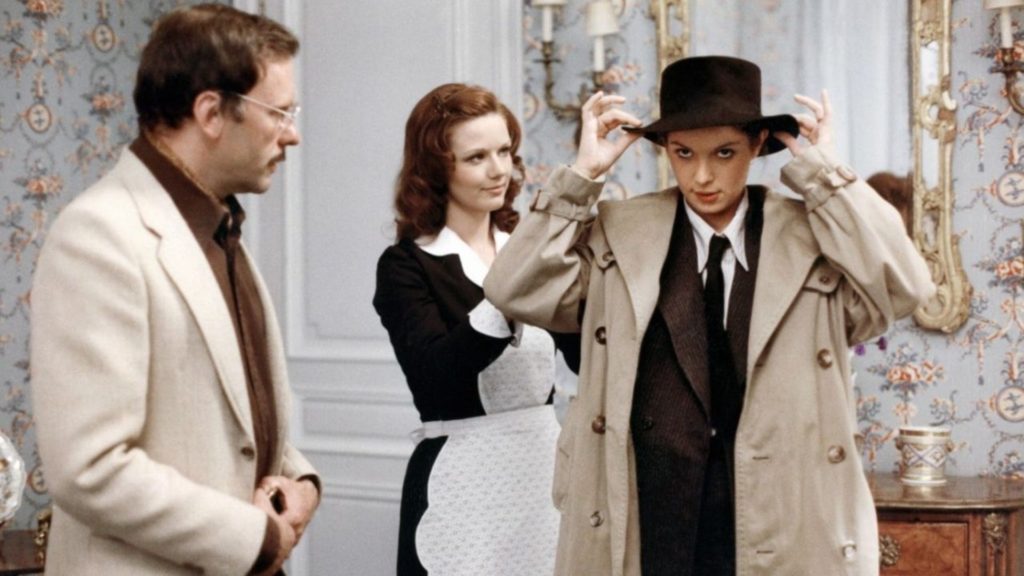
Bonus features for Julia are headlined by Jeremy Richey himself, who provides commentary. Though his delivery can be a tad stilted and his mic could do with a pop filter, he proves to be the easiest listen of the set’s three commentaries. Such accessibility goes a long way in encouraging the viewer to stay with it. Obviously, Richey has done extensive research on all of Kristel’s films; here as he deep-dives on Julia scene by scene, one could be forgiven for assuming his interest centers on this title. He talks with friendly authority about all the talent involved, as well as the film’s context within the “Bavarian Sex Comedy” niche as well as the broader emerging “coming of age sex comedy.” Aside from Richey’s fine commentary, bonuses include a poster & image gallery, as well as Julia’s trailer.
Dutch film historian Peter W. Verstraten provides audio commentary for Wim Verstappen’s WWII drama, Pastorale 1943. He flags up the observation that the Dutch people are widely considered a nice people, but the consequence of that is there tends to be very few heroes. This lands as a criticism of his peoples’ earlier generations who failed to effectively take on the Nazis. He sticks with commenting directly on the scenes at hand, sometimes reduced to momentarily narrating the action on screen. Nevertheless, Verstraten has plenty to say about not only Pastorale 1943, but the entire Dutch film history. All in all, a decent listen.
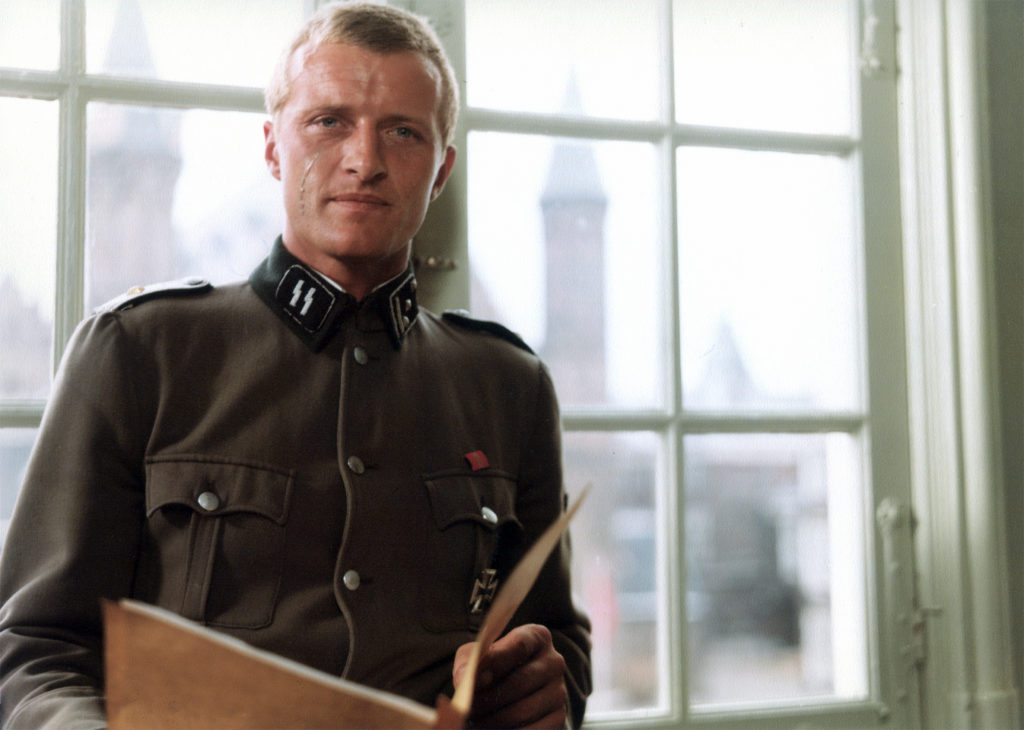
Cult Epics’ Pastorale 1943 disc also presents two on-camera vintage interviews with Kristel, one by herself and the other with Frederik de Groot. The latter runs just over seven minutes. It must be noted that that running time is heavily padded with clips from the film. Not much of Kristel there. The solo interview, however, makes up for it. She takes the opportunity to express her discontent with the Emmanuelle-shaped perception of her stardom while chain smoking. This one runs eleven minutes, and is all her. Like the other discs, other features include a poster and photo gallery, the same trailers, and a brief other “Pastorale promo” piece.
Looping back to 1978’s Mysteries, Cult Epics rounds things out with not one but two audio commentaries. Both are courtesy of returning experts, the first by Peter W. Verstraten; the second by Jeremy Richey. Verstraten goes considerably more in on detailing information on the Dutch film industry than he did with his track over Pastorale 1943. There’s lots of interesting info, but it also requires particularly intent focus to stay with him. Richey’s track is far more approachable, though he does at times read from his own book. When an author has completed a massive coffee table book that includes the topic at hand, one supposes that that author has the right to do so. In any case, Richey’s track remains far more focused on Mysteries itself, and its “punishing” production history. He considers the film “distinct” and “transgressive” in every way. While everyone’s milage may vary in that assessment, Richey’s enthusiasm about the film assures a good listen. Other features include a six-minute Dutch-language behind-the-scenes promotional film, featuring Mysteries cast and crew, a poster & photo gallery, and those trailers again.
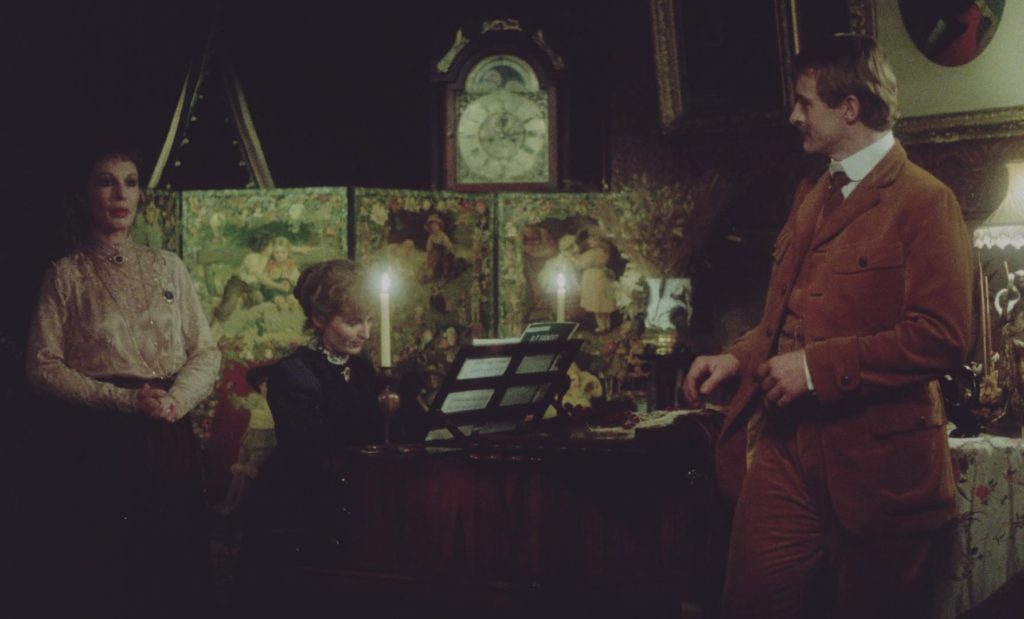
Although the level of detail and care that Cult Epics has poured into these items is no surprise for fans of the company, though these Sylvia Kristel releases exude an “above and beyond” excellence. All films are sourced from new 2K HD transfers (from original 35mm film elements) and restoration and are presented in their native languages with optional subtitles. Each film is on a separate disc, sporting a pertinent image of Kristel. Included in the set’s sturdy red and white beautifully illustrated box alongside the case housing the discs themselves is a 40-page illustrated square-bound booklet featuring excerpts of Jeremy Richey’s writings on each of the four titles, as well as select images carried over from the coffee table book. Additionally, there’s a folded-up poster with the set’s artwork, by Gilles Vranckx.
*****
For those interested in a deep dive into the dynamic 1970s international career of Sylvia Kristel, Cult Epics has you more than covered. Richey’s tome is a beauty unto itself, sweetened by purchase-incentive perks such as a separate poster (not the same poster the Blu-ray set comes with) and the author’s personal autograph. The Blu-ray set is an ideal companion to the book, making four previously very rare Kristel films available in stunning versions. Her career is one of high highs and tragic lows. Learning all about her, her craft, her dedication to it, and her life through it all, helps one to better understand the whole of global film culture and popular culture in the crucially diverse and daring decade of the 1970s.

